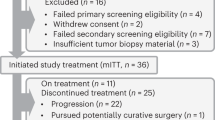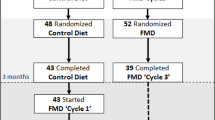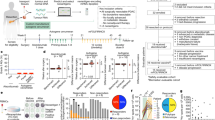Abstract
Macrophage accumulation in atherosclerosis is directly linked to the destabilization and rupture of plaque, causing acute atherothrombotic events. Circulating monocytes enter the plaque and differentiate into macrophages, where they are activated by CD4+ T lymphocytes through CD40–CD40 ligand signalling. Here, we report the development and multiparametric evaluation of a nanoimmunotherapy that moderates CD40–CD40 ligand signalling in monocytes and macrophages by blocking the interaction between CD40 and tumour necrosis factor receptor-associated factor 6 (TRAF6). We evaluated the biodistribution characteristics of the nanoimmunotherapy in apolipoprotein E-deficient (Apoe–/–) mice and in non-human primates by in vivo positron-emission tomography imaging. In Apoe–/– mice, a 1-week nanoimmunotherapy treatment regimen achieved significant anti-inflammatory effects, which was due to the impaired migration capacity of monocytes, as established by a transcriptome analysis. The rapid reduction of plaque inflammation by the TRAF6-targeted nanoimmunotherapy and its favourable toxicity profiles in both mice and non-human primates highlights the translational potential of this strategy for the treatment of atherosclerosis.
This is a preview of subscription content, access via your institution
Access options
Access Nature and 54 other Nature Portfolio journals
Get Nature+, our best-value online-access subscription
$29.99 / 30 days
cancel any time
Subscribe to this journal
Receive 12 digital issues and online access to articles
$99.00 per year
only $8.25 per issue
Buy this article
- Purchase on Springer Link
- Instant access to full article PDF
Prices may be subject to local taxes which are calculated during checkout






Similar content being viewed by others
Change history
26 July 2018
In the version of this Article originally published, the surname of the author Edward A. Fisher was spelt incorrectly as ‘Fischer’. This has now been corrected.
References
Swirski, F. K. & Nahrendorf, M. Leukocyte behavior in atherosclerosis, myocardial infarction, and heart failure. Science 339, 161–166 (2013).
Schönbeck, U. & Libby, P. CD40 signaling and plaque instability. Circ. Res. 89, 1092–1103 (2001).
Lutgens, E. et al. Requirement for CD154 in the progression of atherosclerosis. Nat. Med. 5, 1313–1316 (1999).
Mach, F., Schönbeck, U., Sukhova, G. K., Atkinson, E. & Libby, P. Reduction of atherosclerosis in mice by inhibition of CD40 signalling. Nature 394, 200–203 (1998).
Schönbeck, U., Sukhova, G. K., Shimizu, K., Mach, F. & Libby, P. Inhibition of CD40 signaling limits evolution of established atherosclerosis in mice. Proc. Natl Acad. Sci. USA 97, 7458–7463 (2000).
Lutgens, E. et al. Both early and delayed anti-CD40L antibody treatment induces a stable plaque phenotype. Proc. Natl Acad. Sci. USA 97, 7464–7469 (2000).
Lutgens, E. et al. Deficient CD40–TRAF6 signaling in leukocyte prevents atherosclerosis by skewing the immune response toward an antiinflammatory profile. J. Exp. Med. 207, 391–404 (2010).
Zarzycka, B. et al. Discovery of small molecule CD40–TRAF6 inhibitors. J. Chem. Inf. Model. 55, 294–307 (2015).
Chatzigeorgiou, A. et al. Blocking CD40–TRAF6 signaling is a therapeutic target in obesity-associated insulin resistance. Proc. Natl Acad. Sci. USA 111, 2686–2691 (2014).
Robbins, C. S. et al. Local proliferation dominates lesional macrophage accumulation in atherosclerosis. Nat. Med. 19, 1166–1172 (2013).
Swirski, F. K. et al. Ly-6Chi monocytes dominate hypercholesterolemia-associated monocytosis and give rise to macrophages in atheromata. J. Clin. Invest. 117, 195–205 (2007).
Swirski, F. K. et al. Monocyte accumulation in mouse atherogenesis is progressive and proportional to extent of disease. Proc. Natl Acad. Sci. USA 103, 10340–10345 (2006).
Kiener, P. A. et al. Stimulation of CD40 with purified soluble gp39 induces proinflammatory responses in human monocytes. J. Immunol. 155, 4917–4925 (1995).
Iloki Assanga, S. B. et al. Cell growth curves for different cell lines and their relationship with biological activities. Int. J. Biotechnol. Mol. Biol. Res. 4, 60–70 (2013).
Imhof, B. A. & Aurrand-Lions, M. Adhesion mechanisms regulating the migration of monocytes. Nat. Rev. Immunol. 4, 432–444 (2004).
Wenger, G. D. & O’Dorisio, M. S. Induction of cAMP-dependent protein kinase I during human monocyte differentiation. J. Immunol. 134, 1836–1843 (1985).
Chinetti-Gbaguidi, G., Colin, S. & Staels, B. Macrophage subsets in atherosclerosis. Nat. Rev. Cardiol. 12, 10–17 (2015).
Afford, S. C. et al. CD40 activation induces apoptosis in cultured human hepatocytes via induction of cell surface Fas ligand expression and amplifies Fas-mediated hepatocyte death during allograft rejection. J. Exp. Med. 189, 441–446 (1999).
Bhogal, R. H. et al. Activation of CD40 with platelet derived CD154 promotes reactive oxygen species dependent death of human hepatocytes during hypoxia and reoxygenation. PLoS ONE 7, e30867 (2012).
Tang, Y. et al. Up-regulation of the expression of costimulatory molecule CD40 in hepatocytes by hepatitis B virus X antigen. Biochem. Biophys. Res. Commun. 384, 12–17 (2009).
Kawai, T., Andrews, D., Colvin, R. B., Sachs, D. H. & Cosimi, A. B. Thromboembolic complications after treatment with monoclonal anti-body against CD40 ligand. Nat. Med. 6, 114 (2000).
André, P. et al. CD40L stabilizes arterial thrombi by a β3 integrin-dependent mechanism. Nat. Med. 8, 247–252 (2002).
Ahonen, C. et al. The CD40–TRAF6 axis controls affinity maturation and the generation of long-lived plasma cells. Nat. Immunol. 3, 451–456 (2002).
Duivenvoorden, R. et al. A statin-loaded reconstituted high-density lipoprotein nanoparticle inhibits atherosclerotic plaque inflammation. Nat. Commun. 5, 3065 (2014).
Shah, P. K. et al. Effects of recombinant apolipoprotein A-IMilano on aortic atherosclerosis in apolipoprotein E-deficient mice. Circulation 97, 780–785 (1998).
Moore, K. J., Sheedy, F. J. & Fisher, E. A. Macrophages in atherosclerosis: a dynamic balance. Nat. Rev. Immunol. 13, 709–721 (2013).
Potteaux, S. et al. Suppressed monocyte recruitment drives macrophage removal from atherosclerotic plaques of Apoe –/– mice during disease regression. J. Clin. Invest. 121, 2025–2036 (2011).
Dutta, P. et al. Myocardial infarction accelerates atherosclerosis. Nature 487, 325–329 (2012).
Nissen, S. E. et al. Effect of recombinant ApoA-I Milano on coronary atherosclerosis in patients with acute coronary syndromes: a randomized controlled trial. JAMA 290, 2292–2300 (2003).
Tardif, J. C. et al. Effects of reconstituted high-density lipoprotein infusions on coronary atherosclerosis: a randomized controlled trial. JAMA 297, 1675–1682 (2007).
Lerch, P. G. et al. Production and characterization of a reconstituted high density lipoprotein for therapeutic applications. Vox Sang. 71, 155–164 (1996).
Nykiforuk, C. L. et al. Expression and recovery of biologically active recombinant Apolipoprotein AIMilano from transgenic safflower (Carthamus tinctorius) seeds. Plant Biotechnol. J. 9, 250–263 (2011).
Sanchez-Gaytan, B. L. et al. HDL-mimetic PLGA nanoparticle to target atherosclerosis plaque macrophages. Bioconjug. Chem. 26, 443–451 (2015).
Degoma, E. M. & Rader, D. J. Novel HDL-directed pharmacotherapeutic strategies. Nat. Rev. Cardiol. 8, 266–277 (2011).
Tardif, J. C. et al. Effect of rHDL on Atherosclerosis-Safety and Efficacy (ERASE) Investigators. Effects of reconstituted high-density lipoprotein infusions on coronary atherosclerosis: a randomized controlled trial. JAMA 297, 1675–1682 (2007).
Tardif, J. C. et al. Effects of the high-density lipoprotein mimetic agent CER-001 on coronary atherosclerosis in patients with acute coronary syndromes: a randomized trial. Eur. Heart J. 35, 3277–3286 (2014).
Kim, Y. et al. Single step reconstitution of multifunctional high-density lipoprotein-derived nanomaterials using microfluidics. ACS Nano. 7, 9975–9983 (2013).
Pérez-Medina, C. et al. In vivo PET imaging of HDL in multiple atherosclerosis models. JACC Cardiovasc. Imaging 9, 950–961 (2016).
Ridker, P. M. et al. Rosuvastatin to prevent vascular events in men and women with elevated C-reactive protein. N. Engl. J. Med. 359, 2195–2207 (2008).
Everett, B. M. et al. Rationale and design of the Cardiovascular Inflammation Reduction Trial: a test of the inflammatory hypothesis of atherothrombosis. Am. Heart J. 166, 199–207 (2013).
Ridker, P. M. et al. Antiinflammatory therapy with canakinumab for atherosclerotic disease.N. Engl. J. Med. 377, 1119–1131 (2017).
Stone, G. W. et al. A prospective natural-history study of coronary atherosclerosis. N. Engl. J. Med. 364, 226–235 (2011).
Jonas, A. Reconstitution of high-density lipoproteins. Methods Enzymol. 128, 553–582 (1986).
Pérez-Medina, C. et al. PET imaging of tumor-associated macrophages with 89Zr-labeled high-density lipoprotein nanoparticles. J. Nucl. Med. 56, 1272–1277 (2015).
Langmead, B. & Salzberg, S. L. Fast gapped-read alignment with Bowtie 2. Nat. Methods 9, 357–359 (2012).
Anders, S., Pyl, P. T. & Huber, W. HTSeq — a Python framework to work with high-throughput sequencing data. Bioinformatics 31, 166–169 (2015).
Mudge, J. M. & Harrow, J. Creating reference gene annotation for the mouse C57BL6/J genome assembly. Mamm. Genome 26, 366–378 (2015).
Ritchie, M. E. et al. Limma powers differential expression analyses for RNA-sequencing and microarray studies. Nucleic Acids Res. 43, e47 (2015).
Wang, J. et al. GO-function: deriving biologically relevant functions from statistically significant functions. Brief. Bioinform. 13, 216–227 (2012).
Kanehisa, M., Goto, S., Sato, Y., Furumichi, M. & Tanabe, M. KEGG for integration and interpretation of large-scale molecular data sets. Nucleic Acids Res. 40, D109–D114 (2012).
Acknowledgements
The authors thank the Icahn School of Medicine and the following Mount Sinai’s core facilities: flow cytometry core, quantitative PCR core and TMII’s preclinical imaging core. This study was funded by National Institutes of Health grants R01 HL118440, R01 HL125703 and P01 HL131478 (all to W.J.M.M.), R01 EB009638 (to Z.A.F.) and R01 HL144072 (to W.J.M.M. and Z.A.F.), as well as by NWO grants ZonMW Veni 016156059 (to R.D.) and ZonMW Vidi 91713324 (to W.J.M.M.), and by the European Research Council (ERC Con to E.L.) and by the DFG (SFB 1123-A5 to E.L.).
Author information
Authors and Affiliations
Contributions
R.D. and W.J.M.M. designed the study. R.D., M.L., T.B., M.M.T.v.L., M.L.S., J.T., T.T.P.S., J.K., E.S.G.S., J.O., E.A.F., R.E.T., N.K., P.R., A.K., F.K.S., M.N., Z.A.F., E.L. and W.J.M.M. designed, performed and oversaw the in vivo and ex vivo experiments. F.F., B.L.S.-G. and M.L. developed and produced TRAF6i–HDL. Flow cytometry, histology and immunostaining, laser capture microdissection, and blood chemistry experiments were performed and analysed by R.D., M.L., M.M.T.v.L. and J.M. FMT/CT was performed and analysed by R.D., Y.Y., G.W. and M.N. The RNA sequencing was performed and analysed by X.Z., B.Z., R.D. and M.L. Monocyte migration assays were performed by J.K. PET/CT and pharmacokinetic studies in mice were performed by C.P.-M., J.T. and T.R. 89Zr-PET/MRI in non-human primates was performed and analysed by T.B., M.L.S., C.P.-M. and C.C. The manuscript was written by R.D., M.L. and W.J.M.M. All authors contributed to the writing of the manuscript and approved the final draft. R.D., Z.A.F. and W.J.M.M. provided funding.
Corresponding authors
Ethics declarations
Competing interests
There authors declare no competing interests.
Additional information
Publisherʼs note: Springer Nature remains neutral with regard to jurisdictional claims in published maps and institutional affiliations.
Supplementary information
Supplementary Information
Supplementary figures, tables and video captions.
Supplementary Video 1
Three-dimensional MRI of a non-human primate.
Supplementary Video 2
Three-dimensional PET distribution of 89Zr-labelled TRAF6i–HDL at 60 minutes in a non-human primate.
Supplementary Video 3
In vitro transendothelial migration of monocytes pre-treated with TRAF6i–HD.
Rights and permissions
About this article
Cite this article
Lameijer, M., Binderup, T., van Leent, M.M.T. et al. Efficacy and safety assessment of a TRAF6-targeted nanoimmunotherapy in atherosclerotic mice and non-human primates. Nat Biomed Eng 2, 279–292 (2018). https://doi.org/10.1038/s41551-018-0221-2
Received:
Accepted:
Published:
Issue Date:
DOI: https://doi.org/10.1038/s41551-018-0221-2
This article is cited by
-
Immune checkpoints in cardiac physiology and pathology: therapeutic targets for heart failure
Nature Reviews Cardiology (2024)
-
Role of inflammatory signaling pathways involving the CD40–CD40L–TRAF cascade in diabetes and hypertension—insights from animal and human studies
Basic Research in Cardiology (2024)
-
Engineering biomaterials to tailor the microenvironment for macrophage–endothelium interactions
Nature Reviews Materials (2023)
-
Nanomedicines for cardiovascular disease
Nature Cardiovascular Research (2023)
-
Macrophage-targeted nanomedicine for the diagnosis and treatment of atherosclerosis
Nature Reviews Cardiology (2022)



